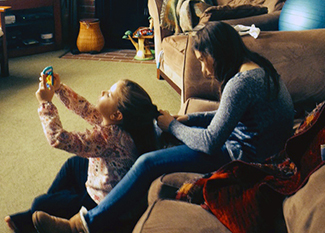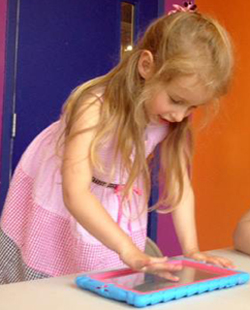The Harvard Family Research Project separated from the Harvard Graduate School of Education to become the Global Family Research Project as of January 1, 2017. It is no longer affiliated with Harvard University.
The Holidays Are Here. Which Apps Will You Share With the Children in Your Life?
PREFACE FROM HFRP
So we asked experts Julie M. Wood and Nicole Ponsford of TechnoTeachers to choose and write about educational apps, online games, and ebooks to enjoy with children of all ages over the holidays. We also asked Harvard Graduate School of Education graduate students Karen Dunham, Laura Alves, Chalatwan Chattrabhuti, and Babe Liberman to compile a list of educational apps (PDF) that are interactive and can engage families in fun learning activities. We hope that you will find these apps a wonderful addition to your holiday festivities and that you will share these recommendations with others!
In 2014 we began writing about how important it is for parents and families to guide children’s use of digital media. The winter holidays are a great opportunity for all of us—parents, grandparents, aunts, uncles, neighbors, siblings—to play and learn with kids and digital media. We know that families are asking for ideas about good, inexpensive apps1 that are fun and support learning, and that, when families and children play and learn with digital media, it is usually a powerful learning experience for all involved.
Winter holidays can be extended family time. It's also a time to learn together, and for many families nowadays, that means using gadgets—tablets, smartphones, and game consoles. As families share a story, play a game, or design a robot, time together means interacting with children in a fun way, and in the process, sparking their curiosity and creativity while helping them develop their language, science, and math skills.
Holidays are a great time for building rapport with the young people in your life and maybe even learning more from them about things to do with the gadgets. This year, why not get ahead of the game? You can download a few apps now and give them a try. That way, as a teacher, you’ll be ready to share the pleasure of anywhere, anytime learning with families as the holidays approach, or, as a parent or grandparent, you’ll be able to astound the digital young ones in your life. You’ll be thrilled to see children and teens intently engaged in activities that are both fun and educational. For inspiration and to get you started, see some of following suggestions for apps that you can try, many of which are free or inexpensive to purchase
 |
| FOUR RULES OF SELECTING APPS |
| What qualities should you look for when selecting digital media for children? Here are four rules of thumb to guide you: |
|
SPARKING CREATIVITY
Want to coauthor a book with a child (ages 5+) right on your iPad or tablet? You can, using Book Creator, which is available in several languages. The art tools invite you to dive in. You can also add music, narration, and video—then save your creations or send them to family and friends (free, but the $4.99 version is a good investment).
Young artists (ages 7+) might enjoy Bug Art. You can explore beautiful bugs with children and help them design their own. These original bugs then come to life in different games ($1.99).
Are arts and crafts your thing? If so, check out ArtLab (ages 7+), developed by the Museum of Modern Art. This app makes it easy for you and a child to create your own sound compositions, poems, group drawings, paintings, and more, then share them with friends and family (free).
Children (ages 6+) who are into super heroes and graphic novels might enjoy the challenge of creating their own comic books. Beginners can experiment with templates, photos, cells, and words using Strip Designer. Older children and teens (ages 8+) can try out ComicBook!, which aims to unleash users’ “creative superpowers” and make it easy for them to add super effects ($2.99 each).
PLAYING PHONICS GAMES
Princess Presto's Spelling Bee and Martha Speaks! You can share these games and more, with preschoolers (ages 3+) at PBS KIDS Games (free).
You can also visit the Starfall website to play games that help beginning readers (ages 3+) recognize letters, and share easy books with readers (ages 4+) (free).
Want to help a child learn letters and words in a fun format? The Endless Reader (ages 3+) is a great way to have fun with beginning reading concepts ($4.99).
SHARING EBOOKS
Looking for Spanish-language resources for preschoolers? Then Kandoobi Animales might be for you. You can learn about over 100 domestic and wild animals, such as avestruzes and perros. Letters, colors, matching activities, and games abound. (Note that this is a Spanish immersion app; an English version is also available.) ($2.99).
 |
| A young girl explores an app at Imajine That Museum |
Preschoolers will be enthralled by The Monster at the End of this Book… starring Grover! by Jon Stone. Try taking turns at guessing what might happen next. The story will keep you and young ones guessing every time you turn the page. Then you can cap it off by watching Sesame Street episodes together and talking about your favorite songs and skits ($4.99).
Then go to the Goodreads website and read through their listings for “Best Free Kindle EBOOKS for Children.” Titles include favorites such as The Tale of Benjamin Bunny by Beatrix Potter, with original illustrations and a highlighted text feature (ages 3+) (free).
Round Is a Mooncake by Roseanne Thong is a book about shapes and is an excellent choice for preschoolers (ages 3+) ($2.99).
For children ages 6-8, download the Reading Rainbow app for an “unlimited library of books and field trips.” Many of the selections can help children understand cultures and traditions from all over the world. As with Sesame Street, you may also want to watch a couple of episodes of Reading Rainbow with children and talk about them together (free).
TAKING ELECTRONIC FIELD TRIPS
Have a dino-nut in the house? Skip traveling through sleet and snow and, instead, visit Dinosaurs, developed by the American Museum of Natural History. This app invites you and a child (ages 4+) to have fun exploring the Museum’s dinosaur exhibits from home ($1.99).
Take children (ages 7+) on a virtual road trip using State Bingo & Road Trip USA. Enjoy zooming through the states at three different levels of challenge ($2.99).
EXPLORING THE NIGHT SKY
Many children (ages 4+) will enjoy going outdoors with you after dark to gaze at the night sky. This is where Star Walk shines. This app has an augmented reality feature that helps you identify stars and constellations as you learn about space ($2.99).
For more educational apps that engage parents and children together, check out the entries we compiled for you in this downloadable guide (PDF). And if you get stuck on how a particular app works, go to YouTube, which offers a vast library of “how to” videos for using apps. Just type in the name of the app you want to see someone demonstrate.
To learn what apps best fit your child’s needs and how to use apps together as a family read Family Time with Apps: A Guide to Using Apps with Your Kids. Available as an interactive iBook or a PDF, this book was designed by The Joan Ganz Cooney Center to help parents understand how apps can support the shared social, emotional, and physical experiences in children’s development and family learning.
The Joan Ganz Cooney Center website also offers up-to-date research on children and media. In particular, see The New Coviewing: Investigating and Designing for Joint Media Engagement, by Lori Takeuchi and Reed Stevens. And for more recommendations on best media for children, visit Common Sense Media. (Both are free.)
Other free resources you might find helpful are:
- Read, Write, Think. Parent & Afterschool Resources offers access to high-quality practices in reading and language arts.
- Reading Rockets offers parents literacy resources and activities, many of which focus on media.
- NAEYC’s For Families website offers information on selecting apps to support children’s learning.
- PBS Parents has a wealth of resources on parenting topics, including tips on children and media.
- Fred Rogers Center for Early Learning and Children’s Media at Saint Vincent College offers "Play and Learn” resources for young children.
SNAPSHOT CONTRIBUTORS:
Julie M. Wood is a creative educational media developer, literacy advisor, writer, researcher, speaker, blogger, and digital media expert. She has served as a faculty member and former director of the Jeanne Chall Reading Lab at the Harvard Graduate School of Education, in Cambridge, MA.
Nicole Ponsford is an award-winning advanced skills teacher of new technologies who works as an edtech writer and school improvement coach. Nicole lives in the United Kingdom and is keen to support the next generation to both aspire and achieve.
1 Please note that links to apps will direct you to the manufacturer website where you can select the device platform, such as iTunes or Android.

